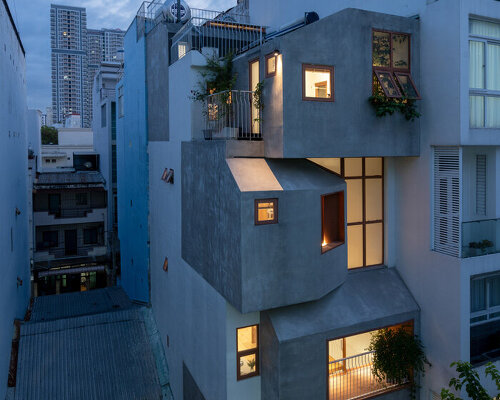Compact Living in Ho Chi Minh City
TiTi’s House is a newly completed residence by NAQI & Partners in Vietnam’s Ho Chi Minh City, situated in the dense fabric of District 10. Designed for a young couple and their three children, the project transforms a narrow fifty-square-meter site into a calm, cohesive living space that balances privacy and shared connection.
From the street, the facade appears modest — white walls set behind a simple metal gate. Early in the day, when the sun is still low, the slanted rooftops cast thin diagonal shadows across the entry steps. A small garden sits to one side of the threshold, softening the line where concrete meets tile. These understated gestures hint at the project’s underlying ambition to provide each family member a sense of individual retreat while maintaining the closeness that comes with living in close quarters.
images © Nguyễn Nhật Anh Chương
Spatial Strategies and Daily Life
The Vietnam-based architects organize the layout of TiTi’s House to unfold vertically across four levels. A central atrium rises through the middle of the plan, drawing daylight deep into the home and allowing air to circulate freely. This void functions as both light well and acoustic bridge. The open-plan layout helps mitigate the constraints of the site. Shared spaces flow into one another without abrupt divisions, while sliding panels and built-in storage provide options for delineating zones when needed. In the evenings, the family gathers on the first floor around a low dining table, the atrium above lending a quiet sense of expansion.
the compact, four-story home is designed by NAQI & Partners in Ho Chi Minh City
Material Palette and Architectural Character
Curating the interiors of TiTi’s House, the team adopts a restrained material and color palette to amplify the perception of space within the dense neighborhood in Vietnam. White walls reflect daylight, complemented by pale grey ceilings and warm timber floors. Where the atrium walls meet the floors, slim steel railings preserve sightlines, making each level feel visually connected to the next.
NAQI & Partners’ custom cabinetry features pitched tops that echo the roofline, a detail inspired by childhood drawings of houses — simple forms with peaked silhouettes. Beds integrate into these built-ins and incorporate storage drawers beneath the mattresses. Throughout the house, there is no unnecessary ornament. Instead, each detail reflects the studio’s commitment to clarity and purpose.
the house occupies a narrow site surrounded by dense urban development
The architects note that in Ho Chi Minh City, rapid urbanization has made narrow tube houses a common typology. TiTi’s House acknowledges this context without surrendering to it. By introducing an internal void and prioritizing adaptable spaces, the design resists the sense of enclosure often associated with constrained footprints. On humid afternoons, the stack effect draws cooler air through operable openings. Even when all five residents occupy different floors, voices and movement remain perceptible as a reminder of shared presence.
The project is described as a study in proportion and perception. Small shifts in ceiling height, combined with carefully placed windows, create moments of openness and enclosure that adjust to the family’s rhythms across the day.
white walls and pale grey ceilings reflect light and enhance the perception of openness
the design prioritizes flexible spaces that support privacy and connection for the family of five
warm timber floors and minimal furnishings create a calm, domestic atmosphere
a central atrium brings daylight and ventilation into every level of the interior spaces
custom cabinetry with pitched tops echoes the silhouette of simple childhood house drawings
project info:
name: TiTi’s House
architect: NAQI & Partners | @naqi.partners
location: Ho Chi Minh City, Vietnam
lead architect: Nguyễn Minh Nhựt
design team: Nhựt Nguyễn, Quỳnh Phan, Hà Tấn Phát, Thơm Nguyễn, Duy Khánh
area: 50 square meters
completion: 2025
photography: © Nguyễn Nhật Anh Chương
The post vietnam architects fill a narrow plot with stacked volumes to shape ‘titi’s house’ appeared first on designboom | architecture & design magazine.

